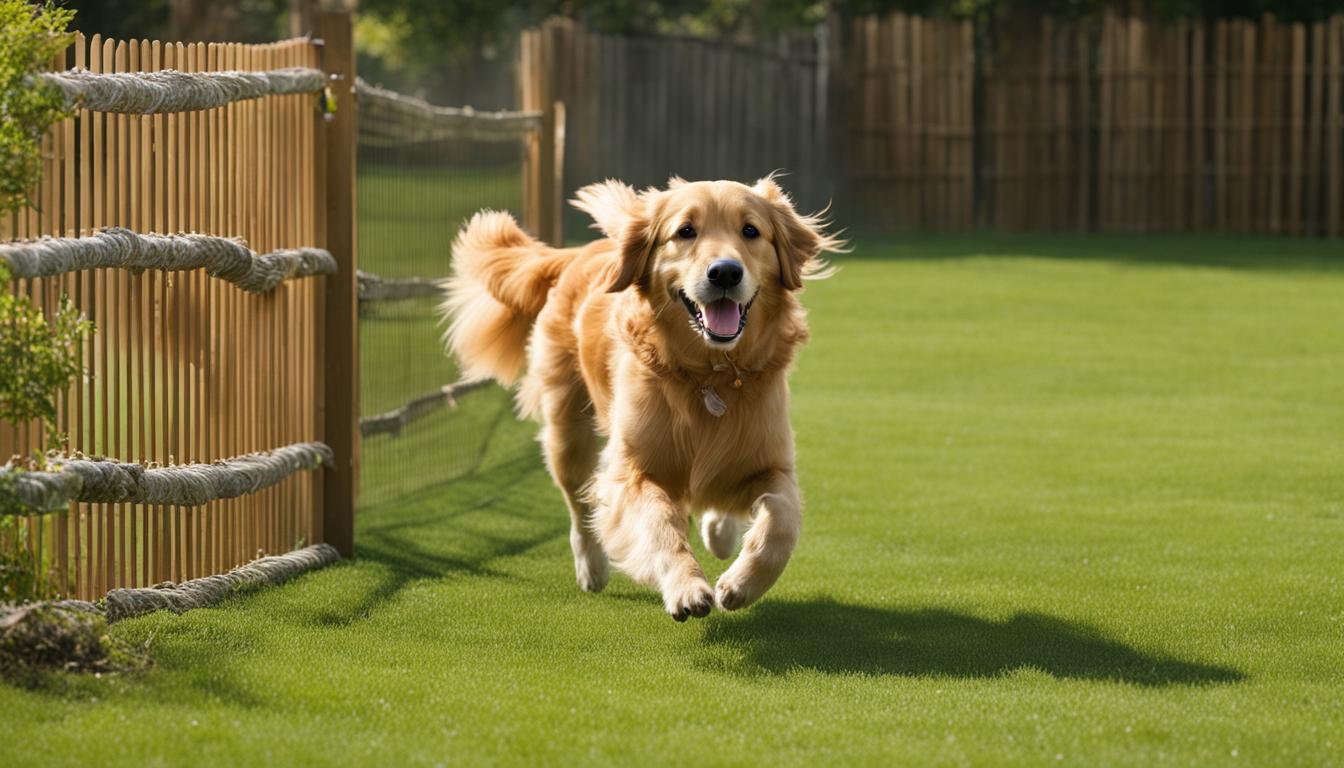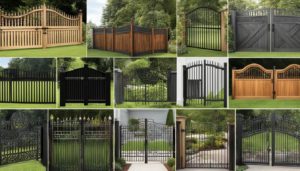Fences are essential for keeping dogs safe and secure in their outdoor space. They provide the freedom for dogs to roam and play without the risk of escaping or encountering potential dangers. There are various types of fences to choose from, including solid wood, chain link, farm fence, iron or aluminum, invisible, vinyl, and plastic. The choice of fence will depend on factors such as privacy, finances, function, and aesthetics.
Key Takeaways:
- Choosing the right fence type is crucial for pet safety and secure outdoor space.
- Consider factors such as privacy, finances, function, and aesthetics when selecting a fence.
- There are various types of fences available, including solid wood, chain link, farm fence, iron or aluminum, invisible, vinyl, and plastic.
- Address specific dog behaviors like jumping, climbing, and burrowing to prevent escapes.
- Additional measures such as airlocks and locks can enhance the security of the fenced yard.
Types of Fences: Choosing the Right Option for Your Yard
When it comes to fencing your yard for your dog, choosing the right type of fence is crucial for creating a secure and safe enclosure. Here are some popular types of fences to consider:
Solid Wood Fences
Solid wood fences are a classic option that provides both privacy and aesthetics. They are commonly used for the portion of the yard facing the street. With a solid barrier, your dog can enjoy their outdoor space without being distracted by external stimuli.
Chain Link Fences
Chain link fences are known for their durability and affordability. They offer visibility, allowing your dog to see beyond the confines of the yard. However, additional measures may be necessary to prevent dogs from reacting to stimuli outside the fence, such as adding privacy elements or creating a buffer zone.
Farm Fences and Iron or Aluminum Fences
If you’re looking for a sturdy option that provides an unobstructed view of your property, farm fences and iron or aluminum fences are excellent choices. These types of fences are popular for larger properties or homes with scenic views.
Invisible Fences
Invisible fences utilize a wireless system to establish boundaries for your dog. These fences work by emitting a signal to a collar worn by your dog. When your dog approaches the boundary, they receive a mild electric stimulation, discouraging them from crossing the invisible fence line. Invisible fences are a great option if you want to maintain an open view without a physical barrier.
Vinyl and Plastic Fences
If you are looking for an affordable alternative that still offers a level of security, vinyl and plastic fences are worth considering. These fences are low maintenance and come in various styles and colors to suit your preferences.
Choosing the right fence for your yard depends on various factors, such as your specific needs, budget, and the size and behavior of your dog. It’s essential to consider both the functionality and aesthetics of the fence to ensure a secure dog enclosure that blends well with your outdoor space.
| Type of Fence | Advantages | Considerations |
|---|---|---|
| Solid Wood Fences | Provides privacy and aesthetics | May require regular maintenance |
| Chain Link Fences | Durable and affordable, offers visibility | Additional measures may be needed for security and privacy |
| Farm Fences and Iron or Aluminum Fences | Sturdy options with unobstructed views | Can be more expensive, may require professional installation |
| Invisible Fences | Maintains open view, wireless system | Training and supervision required, may not be suitable for all dogs |
| Vinyl and Plastic Fences | Affordable and low maintenance | Less durable than other options, limited color choices |
Preventing Common Fence Problems: Solutions for Escape Artists and Reacting Dogs
When it comes to securing your yard for your furry friend, it’s important to address common fence problems that can arise. Whether you have an escape artist dog or a pup that reacts to stimuli outside the fence, there are solutions available to keep them safe and contained.
Addressing Escape Artist Dogs
If your dog is an expert at finding ways to escape, there are several measures you can take. One solution is to create a buffer zone along the fence line using landscaping. This can deter jumping or patrolling behavior by making it less appealing for your dog to approach the fence. Bamboo or reed rolls, garden fencing, or plastic slats can also be added to a chain link fence for enhanced privacy and to prevent dogs from sticking their heads through.
For those dogs that like to dig their way out, L-Footers or concrete footers can be installed to discourage them from burrowing under the fence. Another option is to use coyote rollers or lean-ins, which make it difficult for dogs to climb or jump over the fence. And if extra security is needed, redundant fences, which are fences within fences, can provide an additional layer of protection.
Addressing Reacting Dogs
If your dog tends to react to stimuli outside the fence, it’s important to find solutions that can help keep them calm and prevent fence fighting. One option is to create a visual barrier by adding landscaping or tall shrubs along the fence line. This can help reduce your dog’s exposure to outside distractions and minimize their reactive behavior.
Additionally, if your dog tends to bark at other dogs or people passing by, training and desensitization exercises can be beneficial. Working with a professional dog trainer who specializes in behavior modification can help teach your dog alternative behaviors and reduce their reactivity.
| Preventing Escape | Addressing Reactivity | |
|---|---|---|
| Landscaping | Create a buffer zone along the fence line | Add visual barriers with landscaping or tall shrubs |
| Privacy Options | Use bamboo or reed rolls, garden fencing, or plastic slats | Minimize visual stimuli from outside the fence |
| Digging Prevention | Install L-Footers or concrete footers | Implement training and behavior modification |
| Climbing and Jumping Prevention | Use coyote rollers or lean-ins | Work with a professional dog trainer |
| Extra Security | Consider redundant fences | Provide mental and physical enrichment |
By implementing these solutions, you can prevent common fence problems and create a safe and secure environment for your furry friend.
Keeping Neighbors’ Dogs Out: Ensuring a Secure Boundary
In order to maintain a secure boundary for your dog and prevent unwanted intrusions from neighboring dogs, it is important to take certain measures to address any gaps or vulnerabilities in your fence. By doing so, you can ensure the safety and well-being of your own pet.
Identifying and Filling Gaps
One of the first steps to securing your boundary is to inspect your fence for any gaps between panels and posts. Even small gaps can provide an opportunity for smaller dogs to squeeze through and access your yard. By identifying these gaps, you can take appropriate measures to fill them and make your fence more secure.
There are several methods you can use to fill these gaps, depending on the type of fence you have. For example, if you have a chain link fence, you can attach mesh panels or plastic slats to prevent dogs from easily sticking their heads through. If you have a wooden fence, you can use additional wooden boards or panels to close any gaps.
Choosing the Right Fencing Material
Another important consideration is the type of fencing material you choose. Picket fences or fences with wide gaps may not be suitable for preventing access by smaller dogs. Instead, consider using mesh fencing, such as durable welded wire mesh panels, which provide strength and rigidity while maintaining visibility and security.
| Fencing Material | Advantages | Considerations |
|---|---|---|
| Mesh Fencing (Welded Wire) | Provides strength and rigidity, maintains visibility and security | May not provide complete privacy |
| Chain Link Fencing | Durable, can be combined with climbers to disguise | May not provide complete privacy |
| Wooden Fencing | Provides privacy, can be customized for aesthetics | May require more frequent maintenance |
By choosing the right fencing material, you can enhance the security of your boundary and prevent neighbors’ dogs from accessing your yard.
Addressing Specific Dog Behaviors: Jumpers, Climbers, and Burrowers
Dogs have a natural instinct to explore their surroundings, and some may exhibit behaviors that pose challenges for fence containment. If you have a dog that is a jumper, climber, or burrower, there are measures you can take to address these specific behaviors and prevent escapes.
For jumpers and climbers, extending the height of the fence can be an effective solution. Adding leaning tops or L-footers can make it more difficult for dogs to jump or climb over the fence. Removing any climbing aids, such as nearby structures or furniture, and adding landscaping features like dense shrubs or hedges can also deter them from attempting to escape.
Burrowers, on the other hand, can be deterred by attaching L-footers to the base of the fence or pouring a concrete footer. These measures create a physical barrier that prevents dogs from digging under the fence. Additionally, providing dogs with ample exercise and mental stimulation can help alleviate their desire to escape through digging.
| Specific Dog Behavior | Solution |
|---|---|
| Jumping | Extend fence height with leaning tops or L-footers |
| Climbing | Remove climbing aids, add landscaping features |
| Burrowing | Attach L-footers or pour a concrete footer |
By addressing these specific dog behaviors and implementing appropriate solutions, you can minimize the risk of escapes and create a secure environment for your furry friend. Remember, it’s essential to combine physical measures with proper training and supervision to ensure the safety and well-being of your dog.
Choosing the Right Fence Material: Strength and Functionality
When it comes to choosing the right fence material for your dog, considering both strength and functionality is essential. Your fence needs to withstand the natural wear and tear that comes with having a dog while ensuring that it effectively contains your furry friend within your yard. Here are some factors to consider when selecting the right fence material:
Material Durability:
Opt for materials that offer durability and strength, such as welded wire mesh panels or chain link fences. These options are designed to withstand the energetic behaviors of dogs and provide a secure enclosure for your pet.
Chew-Resistant Options:
If you have a dog that loves to chew, consider materials like chain link or vinyl fences. These materials are less likely to be damaged by chewing and can help prevent your dog from escaping.
Visibility:
Consider the visibility factor of your chosen material. Chain link fences offer clear visibility, allowing you to keep an eye on your dog while they enjoy their outdoor space. If privacy is a concern, you may opt for mesh panels with horizontal reinforcement ribs, which provide a balance between security and visibility.
Remember, the right fence material should not only meet your aesthetic preferences but also provide the necessary strength and functionality to ensure the safety and containment of your beloved pup.
| Fence Material | Strength | Functionality | Chew-Resistant | Visibility |
|---|---|---|---|---|
| Welded Wire Mesh Panels | High | Excellent | Yes | Moderate |
| Chain Link | High | Good | Yes | High |
| Vinyl | Moderate | Good | Yes | Low |
| Wood | Moderate | Good | No | Low |
Invisible Dog Fence Systems: An Alternative Solution
For dog owners who prefer a less visible containment solution, invisible dog fence systems are available. These systems utilize a GPS-enabled device, such as the Fi Smart Dog Collar, to provide continuous tracking of the dog’s location. The system can send alerts if the dog tries to escape, making it easier to locate and retrieve the dog.
Invisible dog fence systems are especially useful for dogs that persistently attempt to escape and require additional containment measures. It is important to note that these systems should not involve any form of punishment, and the focus should be on training the dog to avoid escaping rather than relying solely on the system.
Continous tracking and containment options
The invisible dog fence system offers continuous tracking, allowing dog owners to monitor their pet’s location at all times. This can be particularly beneficial for dogs with a history of escape attempts or those who live in areas with high traffic or potential hazards.
With invisible dog fence systems, containment options are flexible. Boundaries can be easily adjusted to accommodate changes in the yard or property layout. This makes it convenient for dog owners who may need to modify the fence perimeter due to landscaping, construction, or other reasons.
Furthermore, invisible dog fence systems are compatible with multiple pets, allowing owners to monitor and contain several dogs simultaneously. This makes it an ideal solution for households with multiple dogs or pet owners who frequently care for other dogs.
| Pros of Invisible Dog Fence Systems | Cons of Invisible Dog Fence Systems |
|---|---|
| Continuous tracking of dog’s location | Relies on proper training |
| Alerts if the dog tries to escape | Not suitable for all dog breeds |
| Flexible containment options | Requires installation and setup |
| Compatible with multiple pets | May not work well in areas with heavy interference |
Creative Solutions to Prevent Escapes: Extending Boundaries and Enhancing Security
When it comes to keeping your dog safe and secure in your yard, there are many creative solutions available to prevent escapes and enhance the overall security of your dog’s enclosure. By extending boundaries and implementing additional security measures, you can create a safe and secure environment for your furry friend to roam freely without the risk of escaping or encountering potential dangers.
To extend the boundaries of your yard and discourage jumping or climbing, consider adding lean-ins or L-footers to your fence. These additions provide extra height and make it more challenging for dogs to escape. Additionally, incorporating landscaping features such as dense shrubs or hedges along the fence line can create a natural barrier and further deter dogs from venturing near the fence.
In order to enhance security, you can also utilize coyote rollers, which make it difficult for dogs to gain a grip and climb over the fence. These rollers can be installed along the top of the fence and act as a deterrent for escape attempts. By combining these various measures, you can significantly reduce the risk of your dog escaping and ensure their safety within the confines of your yard.
Table: Comparative Analysis of Creative Solutions
| Security Measure | Advantages | Disadvantages |
|---|---|---|
| Lean-ins and L-footers | – Provides extra height to deter escape attempts – Cost-effective solution – Visually blends with the fence |
– Requires professional installation for optimal effectiveness – May alter the overall aesthetics of the fence |
| Landscape features | – Creates a natural barrier – Enhances privacy – Adds aesthetic appeal to the yard |
– Requires regular maintenance – Can take time for plants to grow and provide full coverage |
| Coyote rollers | – Prevents dogs from gaining a grip and climbing over the fence – Easy to install and maintain – Compatible with various fence types |
– May require professional installation for optimal effectiveness – Can be costly depending on the size of the enclosure |
By implementing these creative solutions, you can effectively prevent escapes, extend the boundaries of your yard, and enhance the security of your dog’s enclosure. Remember to choose the solutions that best suit your specific needs, taking into consideration factors such as your dog’s size, behavior, and the type of fence you have. With the right measures in place, you can provide a safe and secure environment where your dog can enjoy the freedom of their fenced-in yard.
Additional Measures to Ensure Safety: Airlocks and Locks
When it comes to dog-proofing your yard, it’s important to consider additional safety measures to ensure the utmost security for your furry friend. Two effective measures to prevent escapes and unauthorized access are airlocks and locks.
Airlocks:
An airlock is a secure area that functions as a double entry system, similar to the ones found in dog parks or boarding facilities. By installing an airlock at the main entrance of your yard, you create a designated space where your dog can be contained safely when the gate is opened. This prevents any accidental escapes before proper supervision is established. Airlocks are particularly useful if you have multiple dogs or young children who might inadvertently leave the gate open. They provide an extra layer of security, ensuring that your dog remains safely within the confines of your yard.
Locks:
Adding locks to your gates and fences is another important safety measure to consider. Locks provide an additional level of protection, preventing unauthorized access to your yard. There are various types of locks to choose from, including padlocks, combination locks, and key locks. Choose a lock that is sturdy, weather-resistant, and tamper-proof to ensure the utmost security. By securing your gates and fences with locks, you can have peace of mind knowing that your dog is safe and protected.
| Airlocks | Locks | |
|---|---|---|
| Function | Create a secure area at the main entrance where dogs can be contained when the gate is opened | Provide an additional level of security and prevent unauthorized access |
| Benefits | Prevents accidental escapes, especially if you have multiple dogs or young children | Ensures utmost security and peace of mind |
| Types | Airlocks | Padlocks, combination locks, key locks |
| Considerations | Choose a suitable airlock size for easy entry and exit | Opt for sturdy, weather-resistant, and tamper-proof locks |
By implementing airlocks and locks in your yard, you can create a safe and secure environment for your dog, preventing escapes and ensuring their well-being. Remember to choose high-quality locks and properly maintain them to guarantee optimal performance. These additional safety measures provide an extra layer of protection, allowing you to enjoy peace of mind while your dog enjoys the freedom of their enclosed space.
Training and Behavioral Considerations: Supporting a Secure Environment
Training plays a crucial role in creating a secure environment for your dog within the fenced yard. By addressing behavioral considerations and implementing effective training techniques, you can prevent escapes and ensure the safety of your furry friend.
One important aspect of training is teaching your dog to understand boundaries. Use positive reinforcement techniques to establish clear boundaries and reinforce the idea that staying within the fence is rewarding. Consistency is key, so make sure to provide regular training sessions and reinforce the desired behavior consistently.
In addition to boundary training, it’s essential to address any specific behavioral issues that may contribute to escape attempts. For example, if your dog tends to jump or climb fences, work on teaching them alternative behaviors that are more desirable, such as sitting or staying. You can also provide mental and physical stimulation, such as interactive toys or puzzle games, to redirect their energy and prevent boredom-related escape attempts.
Training Tips for a Secure Environment:
- Establish clear boundaries through positive reinforcement training.
- Consistently reinforce desired behavior and discourage escape attempts.
- Address specific behavioral issues that contribute to escapes, such as jumping or climbing.
- Provide mental and physical stimulation to prevent boredom-related escapes.
Remember, training takes time and patience, so be consistent and persistent in your efforts. By investing in training and behavioral considerations, you can create a secure environment for your dog within the fenced yard, ensuring their safety and your peace of mind.
| Training Techniques | Benefits |
|---|---|
| Positive reinforcement | Encourages desired behavior |
| Redirecting energy through mental and physical stimulation | Prevents boredom-related escapes |
| Consistency and persistence | Establishes clear boundaries |
| Addressing specific behavioral issues | Discourages escape attempts |
Conclusion
Fencing a yard for a dog is essential to ensure the safety and well-being of your beloved pet. With the wide range of options available, you can choose a fence type that suits your needs, whether it’s solid wood for privacy, chain link for durability and visibility, or an invisible system for a less visible solution.
Preventing common fence problems, such as escape attempts and reacting to stimuli, can be achieved through various solutions. From landscaping and adding privacy features to deterring climbers and burrowers, you can enhance the security of your dog enclosure.
Choosing the right fence material is crucial for strength and functionality. Mesh fencing or chain link options are ideal for robust containment, while vinyl fences are a great alternative for dogs that chew on wooden fences.
By implementing additional measures such as extending boundaries, adding locks, and creating airlocks, you can further enhance the security of your pet’s outdoor space. Remember that training and behavioral considerations play a crucial role, so invest time and effort into teaching your dog to respect boundaries and avoid escape attempts.
In conclusion, by following the guidelines and strategies outlined in this guide, you can create a safe and secure environment for your dog. With the proper fencing and necessary precautions in place, you can enjoy peace of mind while your furry friend enjoys the freedom and safety of their enclosed yard.
FAQ
Why is it important to fence a yard for a dog?
Fencing a yard is essential for keeping dogs safe and secure in their outdoor space, preventing them from escaping or encountering potential dangers.
What are the different types of fences available?
Some common types of fences include solid wood, chain link, farm fence, iron or aluminum, invisible, vinyl, and plastic. The choice of fence will depend on factors such as privacy, finances, function, and aesthetics.
How can I address fence problems caused by neighboring dogs?
To prevent neighbors’ dogs from entering your yard, it is important to address any gaps between panels and posts and choose a fencing material that is suitable for dog containment, such as mesh or welded wire panels.
What can I do to prevent my dog from escaping through the fence?
There are several solutions to address specific dog behaviors like jumping, climbing, or burrowing. These include extending the fence with leaning tops or L-footers, adding landscaping, or attaching Coyote rollers to make it difficult for the dog to escape.
Which fence material should I choose for my dog?
Picket fences or barbed wire may not be suitable for dogs. Mesh fencing, such as welded wire mesh panels, can provide strength and visibility while chain link and vinyl fences are also good options. The choice depends on your specific needs and preferences.
What are invisible dog fence systems?
Invisible dog fence systems use a GPS-enabled device to establish boundaries and discourage dogs from crossing them. These systems can provide continuous tracking of the dog’s location and send alerts if the dog tries to escape.
How can I prevent my dog from escaping without using a traditional fence?
Creative solutions such as extending the fence with lean-ins or L-footers, adding landscaping features, and installing airlocks at the entrance can help prevent escapes and enhance security.
What additional measures can I take to ensure my dog’s safety within the yard?
Installing airlocks at the main entrance and adding locks to the gates and fences can provide an extra layer of security and prevent unauthorized access.
Training plays a crucial role in preventing fence-related problems. By investing time and effort into training your dog and providing regular exercise, you can help them understand boundaries and reduce the likelihood of escape-related behaviors.




